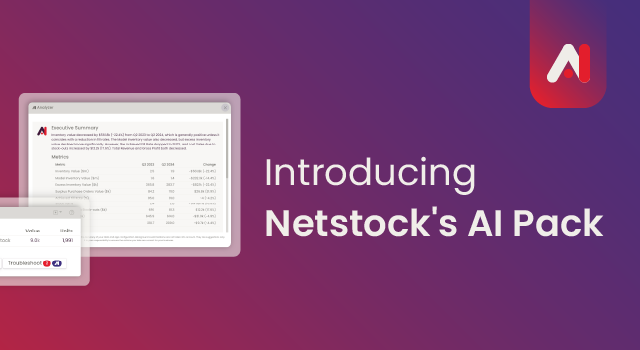Only the most efficient and agile businesses can survive in a world where global supply chains and online markets dominate. Customers must receive the service they expect, or sales will suffer.
In competitive markets, businesses must offer service excellence while driving costs down, and inventory plays a vital role in both customer service and cost management. Yet, many organizations still manage inventory using manual systems. They carry more stock than they need, reacting to stock-outs and surpluses too late.
Modern inventory management software eliminates the need for reactive ordering. Predictive inventory management and flexible demand forecasting capabilities allow businesses to hold lower stock levels without risking stock-outs.
Take this new proactive approach to inventory management and release capital tied up in inventory so you can invest in exciting new business ventures with real-time inventory management systems.
What is inventory management?
Inventory encompasses all stocks, from raw materials to finished goods and everything in between. Inventory is the lifeblood of most organizations. Efficient inventory management drives revenue generation as it represents a large share of the current assets in many businesses.
Effective inventory management solutions are critical for enterprise profitability and customer satisfaction. Inventory management is the act of balancing stock-outs and carrying too much stock. If you run out of stock, you’ll upset customers and incur expedited transport costs. If you order more than you need, your cash flow will suffer. Storage, insurance, and finance costs of surplus stock will impact profitability. What your business needs is the lowest possible inventory without risking stock-outs.
Data-driven decisions
Demand planners rely on precise information to manage inventory efficiently. This includes accurate demand forecasts, current stock figures, and up-to-date supplier data. These insights help determine the appropriate levels of safety stock, re-order points, and supplier delivery schedules.
Proactive solutions such as Netstock’s predictive demand forecasts play a crucial role in inventory management. By leveraging data analytics, these solutions provide valuable insights into market demands and supplier performance. This enables the establishment of dynamic order points, leading to optimal inventory levels, reduced capital tied up in inventory, and ultimately, maximized profits.
What are common inventory management techniques?
Several inventory management solutions have developed over the last few decades. Here are the most used techniques:
1. Just-in-Time (JIT) Inventory Management
The idea behind Just-in-Time inventory management is to reduce or even eliminate inventory. These systems work on visual pull systems, where the supplier replenishes the stock as it is used. While JIT works well in a production facility where usage is known and constant, it may not be practical where demand is unpredictable.
2. Economic Order Quantity (EOQ)
The EOQ is widely used in inventory management to balance the costs of holding inventory with the annual demand and cost of ordering. This is the formula:
Where:
EOQ = √2(DQ/H)
D = Annual demand
Q = Purchase cost per order
H = Inventory holding cost
3. ABC Analysis
ABC analysis is a method used for inventory management and categorizes stock items into three categories. The system, based on Pareto’s 80/20 rule, states that 20% of our efforts result in 80% of the results. Using an ABC analysis, items are classified according to their importance and value to the organization. This classification allows management to concentrate efforts on a select few items. A-items are more closely monitored than B or C-items. The most important items would receive an A classification because of volume, value, or profitability.
4. Vendor-Managed Inventory (VMI)
With this system, the vendor continuously replenishes stock to a predetermined level. Vendors must plan their production according to market demand. To do this, they must have access to customer inventory and demand information. Suppliers receive signals when the stock low limit is reached. These systems depend on open collaboration across the supply chain.
5. Just-in-Case (JIC) Inventory Management
Companies that manage demand surges or lack accurate forecasts sometimes opt for a JIC system. Under this system, the company will carry more stock than it needs to ensure it never runs out of stock. The downside of JIC is that the company’s inventory holding costs will be higher than necessary. The capital invested in the stock is not available for use elsewhere, and the company risks obsolescence over the long run. It also forfeits market agility, restrained as it is by excess stocks.
Inventory management processes and systems
Real-time inventory software has become a reality. These systems accurately manage inventory and optimize ordering. Real-time tracking ensures transparency across the supply chain. The result is better coordination, faster response times and improved efficiency.
These systems calculate ideal order points and automatically release orders when the stock drops to a pre-defined level. They analyze data to provide more accurate demand forecasts and inform ordering decisions. The result is lower inventories without the risk of stock-outs. Both upstream and downstream businesses reap benefits in collaborative supply chains.
An automated inventory system can integrate with your existing ERP, and this can simplify implementation and user training.
What are the best practices in inventory management
Inventory management systems have evolved significantly over the years, now offering faster access to more extensive data.
Below are some of the commonly used inventory management tools:
- Lean inventory management: Originating in the Toyota factory in Japan, lean emphasizes the elimination of all waste. Excess inventory, unnecessary tasks, and quality problems represent waste. Lean is a simple visual system that uses JIT and VMI as the driving inventory control systems.
- Automated inventory systems: Automated inventory systems can help eliminate waste in a business. These systems use data analytics to improve demand forecasting, automate order releases, and monitor inventory in real-time.
- Collaborative supply chains: Open and accurate real-time information shared with customers and suppliers drives improvements throughout the supply chain. Collaborative data sharing reduces lead times, inventory holding and stock-outs.
Inventory management strategies
Modern inventory systems are intricate, encompassing multiple stages and diverse products with varying supply characteristics. Managing such systems efficiently is impractical using manual orders and spreadsheets alone.
Efficient supply chains run off collaborative systems that inform upstream and downstream demand planning and inventory deployment. VMI systems allow for automatic order replenishment, optimizing stock levels. Automated order fulfillment reduces the workload and releases employees to do more value-added tasks. Modern business inventory systems effectively steer all these strategies.
Omni-channel Inventory Management
In today’s online world, businesses must adapt to customer expectations and manage stocks across multiple channels. Only a centralized system can eliminate data silos to handle such complex multi-channel supply chains. Only accurate real-time data can offer customers the seamless shopping experience they expect.
Role and functions of inventory management
The importance of inventory management cannot be overstated. It’s the foundation upon which the organization’s customer service, current asset management and profitability depend. It ensures that customers find what they want when they want it without risking stock-outs.
Inventory control
Inventory control focuses specifically on the processes and practices used to regulate and manage inventory levels within predefined parameters, ensuring optimal stock levels.
Effective inventory control software must rest on a foundation of policies and procedures designed to maintain inventory at appropriate levels. Essential inventory control aspects include:
- Cycle counts: Regular reconciled cycle counting should identify system issues and retain confidence in the inventory data.
- ABC analysis: ABC analysis defines group parameters for resource allocations. A-items need firm control, moderate control for B-items and more flexible control for C-items.
- Dynamic order quantities: Install dynamic order quantities with AI inventory management using data analysis as a basis for stock control.
- Collaborative data sharing: Ensure real-time data drives decisions throughout the supply chain. Demand planning is simplified at all levels, upstream and downstream.
- Inventory and Enterprise Risk Management (ERM): Inventory risks should form an integral part of your ERM. Businesses that take a proactive approach to risk with ERM will appreciate AI inventory management’s proactive stance. Regularly monitoring and reporting with cycle counting and continuous improvement actions will ensure that your inventory controls stay relevant.
Inventory management in business operations
Enterprise inventory management software must support inventory for all business operations.
Inventory management in production
In manufacturing environments, materials requirements are calculated rather than forecast. The production plan may be based on demand forecasting or orders based on the sales environment.
The Material Requirements Plan (MRP) factors in available inventory and expected deliveries to plan and schedule future purchase orders. Accurate inventory and product information is, therefore, a prerequisite for planning materials to support the production plan. Stock-outs in production are very costly as they may stop an entire production line.
Stock in maintenance and service environments
Preventative maintenance is an essential aspect of production environments. Spares and consumables support maintenance efforts. Most businesses stock essential spares and may use reorder points to replenish the stock. In some instances, maintenance spares and consumables can constitute a considerable investment and may benefit from dynamic order points.
Similarly, in service environments, management must plan and schedule resources, ensuring capacity to support customers. Stocks of critical spares may be planned and held in stock.
Inventory management systems and tools
Enterprise inventory management software solutions offer a comprehensive suite of features. These systems can manage high-volume inventories and complex multi-level supply chains. They use a single platform to track and manage inventory levels across many warehouses and locations.
Production planning and control, vendor-managed inventories, and accounting solutions are fully integrated, allowing for transparency and integrated receipts and payments.
The Netstock system integrates with most ERP systems, offering businesses world-class forecasting and predictive inventory planning. Employees can quickly learn the ropes, ensuring swift and trouble-free implementation with your current ERP software.
Training and implementation of inventory management
New process implementation can disrupt everyday activities, and you’ll need strategies for a smooth transition.
- Stakeholder involvement: Involve all stakeholders in the project from the start.
- Clear communication: Ensure transparency and clearly communicate the reasons for the change, encouraging open communication.
- Information: Keep people informed of the implementation progress and upcoming changes.
- Training: Training is essential for a successful inventory management implementation. Staff must understand and know how to apply inventory management principles. Plan training programs to equip staff with the required skills. Netstock’s Learning Academy provides a library of tutorials for ongoing information and to remind employees about the basics.
- Ongoing support and feedback: Offer ongoing support and gather feedback from users to continuously improve the system.
- Standard operating procedures: You’ll need standardized procedures for everyday activities like receiving and picking.
- Track progress: Use the reporting system to track key metrics like stock levels and trends. Then, use data-driven decisions to improve the system.
Optimize your inventory and make your money work for you
Maintaining a healthy inventory system requires precise and up-to-date information, and it can have a significant impact on your business’s profitability. By leveraging data-driven demand forecasts, you can optimize your inventory levels and improve your customer service, resulting in better cash flow and profits. Don’t let your capital get tied up in the wrong inventory.
With Netstock, you can avoid wasting capital on unnecessary inventory by employing AI-driven technology to proactively optimize your inventory and maximize returns.




